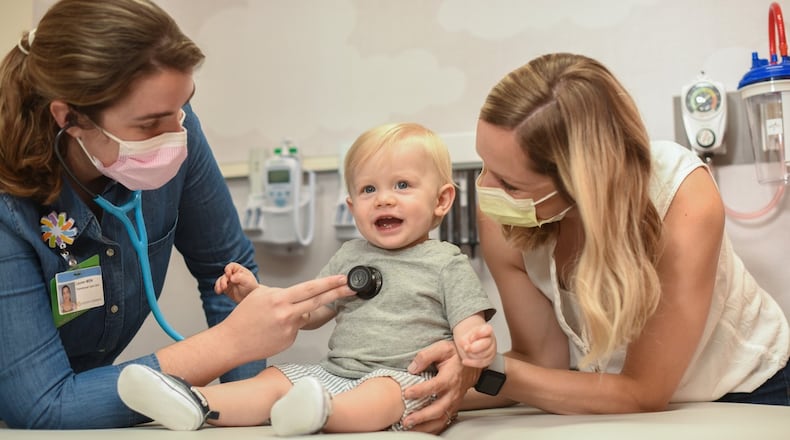“Right now, we are seeing a gradual increase in the numbers of COVID positive patients,” said Dr. Michael Klatte, chief of infectious disease at Dayton Children’s Hospital. “Most of these have been outpatients and haven’t required hospitalization, but we have had a few cases that have been hospitalized recently with severe COVID infection, most of those have been on the younger side.”
The cases have been picking up over the last month or two, but it’s been nowhere near the peaks they saw last winter, Klatte said.
That gradual uptick is consistent with what’s being seen throughout the rest of the country particularly with the “FLiRT variants,” Klatte said.
The FLiRT variants are a group of COVID variants named after the technical names for their mutations, including KP.2, JN.1.7, and any other variants starting with KP or JN, according to John Hopkins Bloomberg School of Public Health. They are all descendants of the JN.1 variant, which has been dominant in the U.S. for the past several months.
“I would expect they would continue to increase for a time, now the kids are back in school, before decreasing again. Though, what everyone across the country, all the national experts are concerned about is another wave, particularly during the winter time,” Klatte said.
Sinus, flu-like symptoms
Adults are similarly feeling the impact of COVID spreading.
“Over the past three weeks, there’s been a noticeable rise in COVID cases,” said Dr. Josh Ordway, a family medicine doctor at Premier Health’s Springboro Family Care.
Patients have been calling in after testing at home or they’ve been coming to visits with typical respiratory symptoms and testing positive for COVID, he said.
Symptoms patients are experiencing range from symptoms similar to a sinus infection up to severe flu-like symptoms, he said.
“I haven’t seen a lot of the hospitalizations and ventilator type of illnesses that we saw initially with COVID, thankfully,” Ordway said.
Severe cases are still happening, but most cases Ordway is seeing are either cold or flu-like symptom.
The rise in illnesses is expected since children and adolescents are returning to school.
“Once you have people who are congregating in enclosed spaces like classrooms, like family gatherings, it really increases the transmission rate,” Ordway said.
RSV vaccinations
Doctors are hoping more infants will get vaccinated against respiratory syncytial virus (RSV) this fall.
“We’re really hopeful that if the uptake is high, that our numbers of infants hospitalized with severe RSV will be lower than in previous years,” Klatte said.
Across the country last year in children younger than five years old, RSV accounted for the greatest number of hospitalizations of any of the respiratory viral illnesses, he said.
“More so than COVID. More so than influenza,” Klatte said.
The more infants and young children who receive the monoclonal antibody vaccination this year, the fewer serious cases doctors expect to see this fall and winter, he said.
“That will help ease potential winter time congestion for our hospital, as well as other hospitals throughout the area and the country,” Klatte said.
Last winter, Dayton Children’s saw very high numbers of RSV infections in infants and young children.
While the vaccine nirsevimab, trade name Beyfortus, was available last year after the U.S. Food and Drug Administration approved it, demand was high and supply was limited, Klatte said.
This year, doctors believe the supply of nirsevimab will be readily available in the fall, around October, he said.
Nirsevimab, a long-acting monoclonal antibody product, was 90% effective in preventing infants from being hospitalized due to RSV between October 2023 and February 2024, a report from the Centers for Disease Control and Prevention earlier this year says.
RSV is the leading cause of hospitalization among infants in the U.S., the CDC says. Between 58,000 and 80,000 children under 5 years of age, mostly infants, are hospitalized each year nationwide due to an RSV. An estimated 100 to 300 children younger than 5 years old die due to RSV each year, according to the CDC.
Dayton Children’s recommends children be vaccinated with their respective immunizations for respiratory illnesses, like COVID, the flu and RSV if applicable, by around Halloween.
Though vaccines will still be available after that point, getting shots by the end of October will help give their immune systems extra protection when winter illnesses take hold.
Adults are also recommended to get their annual flu and COVID shots later this fall. People 75 or older, or between 60-74 with certain chronic health conditions or living in a nursing home, can get one dose of the RSV vaccine to provide an extra layer of protection. There are three RSV vaccines licensed by the FDA for use in adults aged 60 and older in the U.S.
“Once the temperature starts to fall, our immunity actually drops as well, so that will be another rise in the cases of these kind of upper respiratory infections,” Ordway said.
About the Author

